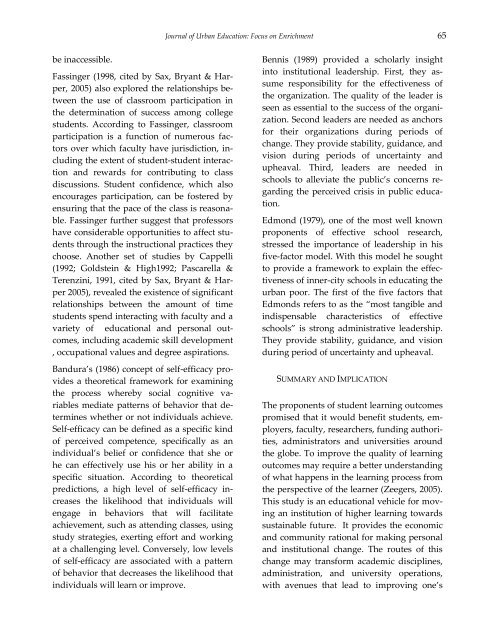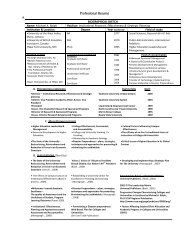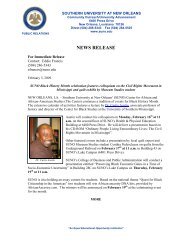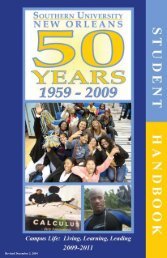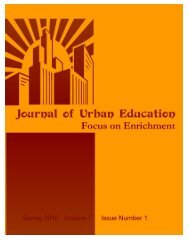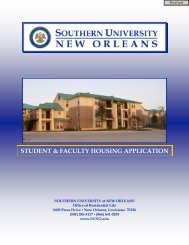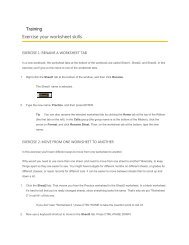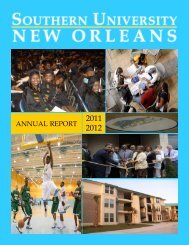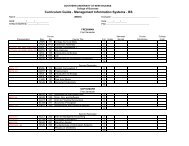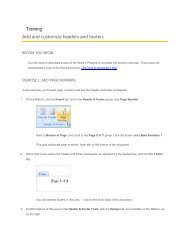Journal of - Southern University New Orleans
Journal of - Southern University New Orleans
Journal of - Southern University New Orleans
- No tags were found...
Create successful ePaper yourself
Turn your PDF publications into a flip-book with our unique Google optimized e-Paper software.
<strong>Journal</strong> <strong>of</strong> Urban Education: Focus on Enrichment 65be inaccessible.Fassinger (1998, cited by Sax, Bryant & Harper,2005) also explored the relationships betweenthe use <strong>of</strong> classroom participation inthe determination <strong>of</strong> success among collegestudents. According to Fassinger, classroomparticipation is a function <strong>of</strong> numerous factorsover which faculty have jurisdiction, includingthe extent <strong>of</strong> student-student interactionand rewards for contributing to classdiscussions. Student confidence, which alsoencourages participation, can be fostered byensuring that the pace <strong>of</strong> the class is reasonable.Fassinger further suggest that pr<strong>of</strong>essorshave considerable opportunities to affect studentsthrough the instructional practices theychoose. Another set <strong>of</strong> studies by Cappelli(1992; Goldstein & High1992; Pascarella &Terenzini, 1991, cited by Sax, Bryant & Harper2005), revealed the existence <strong>of</strong> significantrelationships between the amount <strong>of</strong> timestudents spend interacting with faculty and avariety <strong>of</strong> educational and personal outcomes,including academic skill development, occupational values and degree aspirations.Bandura’s (1986) concept <strong>of</strong> self-efficacy providesa theoretical framework for examiningthe process whereby social cognitive variablesmediate patterns <strong>of</strong> behavior that determineswhether or not individuals achieve.Self-efficacy can be defined as a specific kind<strong>of</strong> perceived competence, specifically as anindividual’s belief or confidence that she orhe can effectively use his or her ability in aspecific situation. According to theoreticalpredictions, a high level <strong>of</strong> self-efficacy increasesthe likelihood that individuals willengage in behaviors that will facilitateachievement, such as attending classes, usingstudy strategies, exerting effort and workingat a challenging level. Conversely, low levels<strong>of</strong> self-efficacy are associated with a pattern<strong>of</strong> behavior that decreases the likelihood thatindividuals will learn or improve.Bennis (1989) provided a scholarly insightinto institutional leadership. First, they assumeresponsibility for the effectiveness <strong>of</strong>the organization. The quality <strong>of</strong> the leader isseen as essential to the success <strong>of</strong> the organization.Second leaders are needed as anchorsfor their organizations during periods <strong>of</strong>change. They provide stability, guidance, andvision during periods <strong>of</strong> uncertainty andupheaval. Third, leaders are needed inschools to alleviate the public’s concerns regardingthe perceived crisis in public education.Edmond (1979), one <strong>of</strong> the most well knownproponents <strong>of</strong> effective school research,stressed the importance <strong>of</strong> leadership in hisfive-factor model. With this model he soughtto provide a framework to explain the effectiveness<strong>of</strong> inner-city schools in educating theurban poor. The first <strong>of</strong> the five factors thatEdmonds refers to as the ‚most tangible andindispensable characteristics <strong>of</strong> effectiveschools‛ is strong administrative leadership.They provide stability, guidance, and visionduring period <strong>of</strong> uncertainty and upheaval.SUMMARY AND IMPLICATIONThe proponents <strong>of</strong> student learning outcomespromised that it would benefit students, employers,faculty, researchers, funding authorities,administrators and universities aroundthe globe. To improve the quality <strong>of</strong> learningoutcomes may require a better understanding<strong>of</strong> what happens in the learning process fromthe perspective <strong>of</strong> the learner (Zeegers, 2005).This study is an educational vehicle for movingan institution <strong>of</strong> higher learning towardssustainable future. It provides the economicand community rational for making personaland institutional change. The routes <strong>of</strong> thischange may transform academic disciplines,administration, and university operations,with avenues that lead to improving one’s


